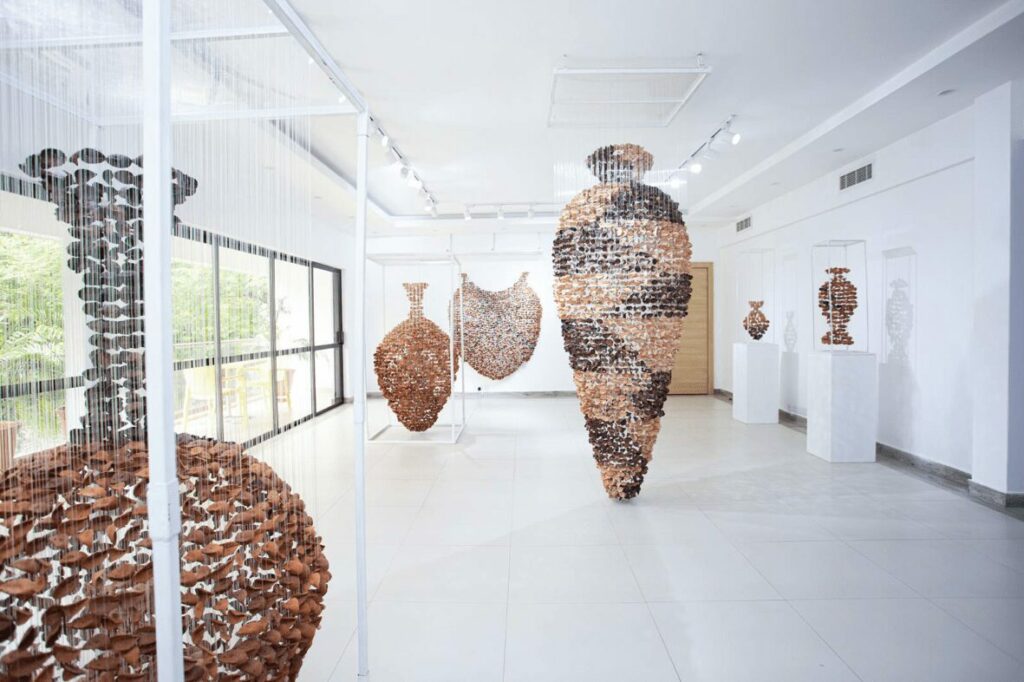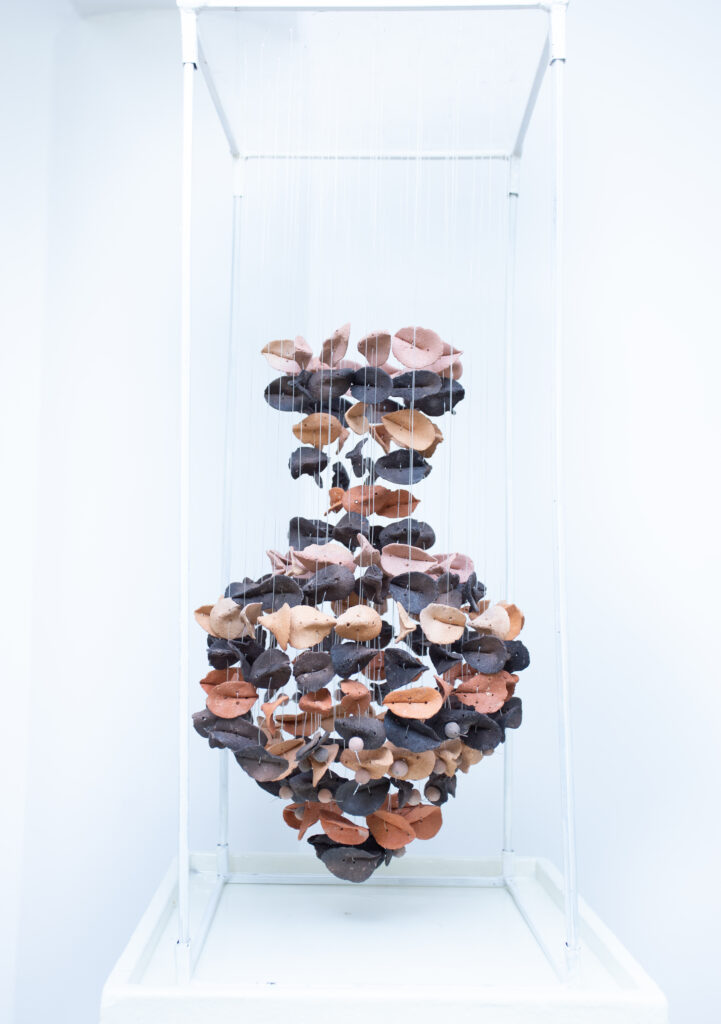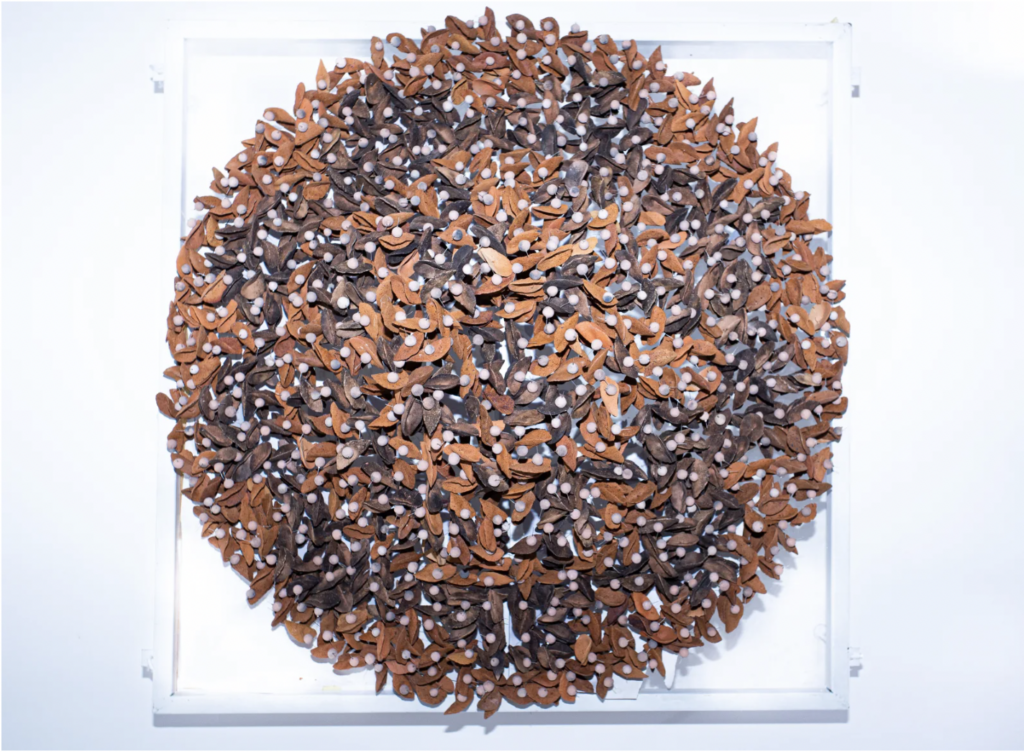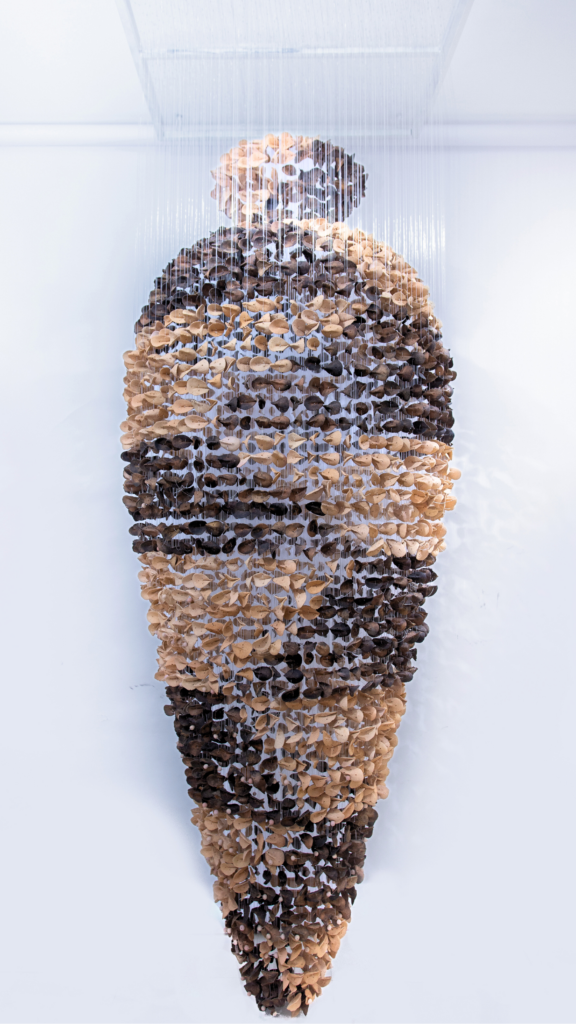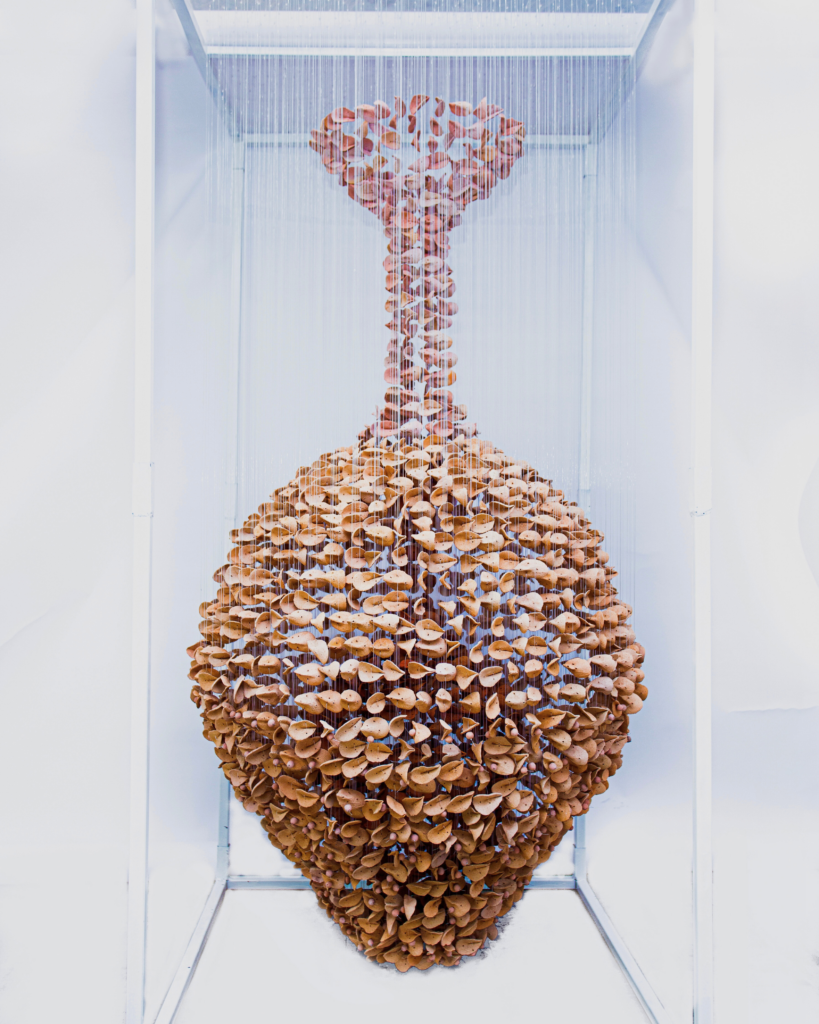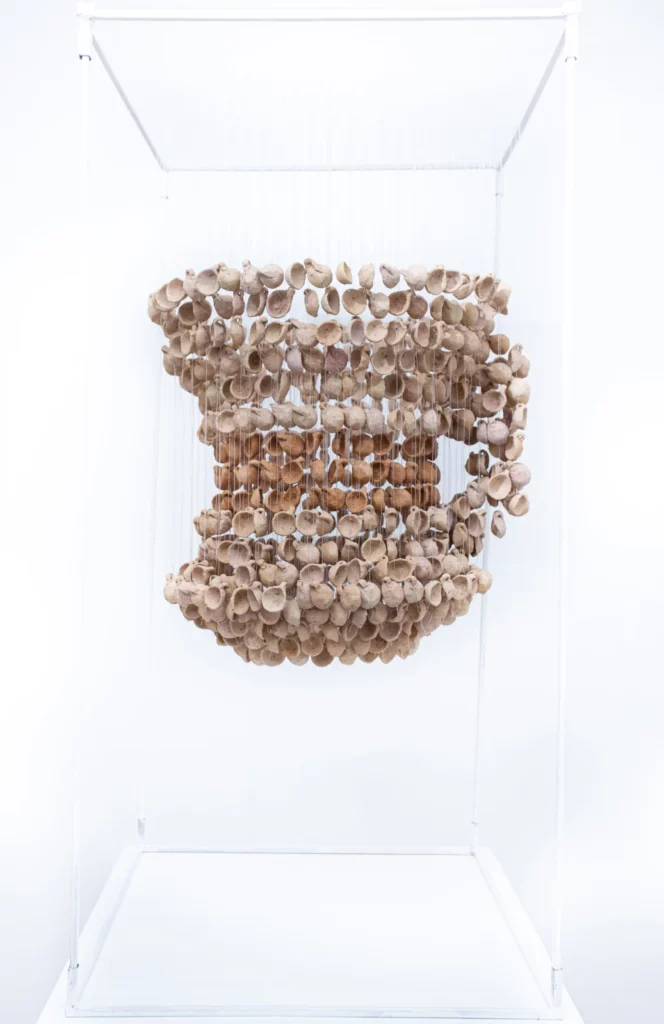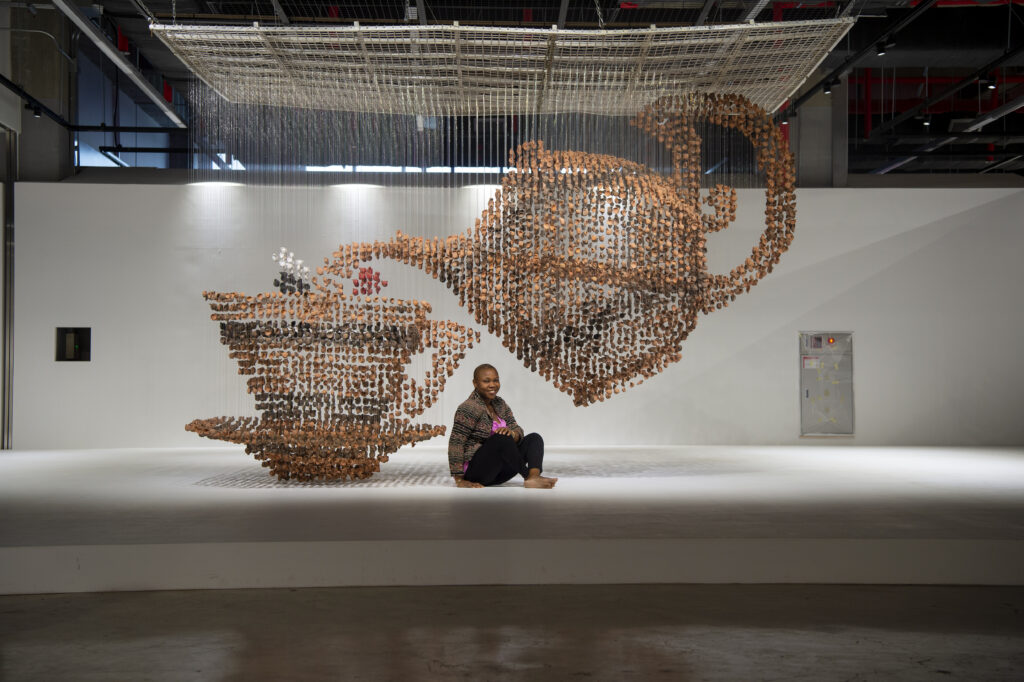
Ceramic artist Ngozi-Omeje Ezema was born in Nssuka, Nigeria in 1979. She currently lives and works in Nigeria.
Recent exhibitions include the Dakar Biennale in Senegal (2020), Cheongju Craft Biennale in South Korea (2019), Saatchi StART Art Fair in London (2018), the Faenza Biennale in Italy (2018) and the First West African Art Fair in Lagos (2016).
interview with ceramic artist Ngozi-omeje ezema
Ngozi-Omeje Ezema is a forerunner in the interrogation of clay and its transformative capabilities. Born and raised in eastern Nigeria, Ezema studied Fine Applied Art at the University of Nigeria, Nsukka, where she later received her Master’s degree in the same field. One of the most prominent artists to have come out of the Nsukka school, El Anatsui, had a significant impact on her work and practice, as we see the shared idea of material repetition to the effect of reimagining the object in its entirety, across both artists’ practices. Ezema was first drawn to clay for its malleable, tactile properties, finding that it gave her the freedom to expand the boundaries of traditional ceramics. With a preliminary understanding of the fundamentals of ceramic technique, such as wheel throwing and hand-coiling, Ezema began, what has since developed into a pioneering exploration of the diversification of the medium. Through her work, the medium, often seen in tandem with the earth, is raised and left suspended in the air. Using thin nylon threads to suspend small leaf-shaped clay pieces, Ezema creates unique reimaginings of various familiar objects: ranging from elephants, teacups, whales and vases. By doing so, she redefines the medium as the substance of the definitive object and instead interjects notions of negative space into our perception of everyday imagery. Under such conditions, she not only expands the boundaries of ceramic capability, but in so doing feels better equipped to prompt reflection on societal issues such as the gendered framework of the predominantly patriarchal Nigerian culture. Her Leaf Series, from 2020, for example, uses these leaf-like units of clay to form vases that transcend the pre-conceived. Ezema has likened these multi-surface vessels to the layered roles traditionally occupied by women, drawing a parallel between the presumed function of a vase and the societal expectations imposed on mothers and women. However, these suspended forms, resembling instead the potential of a vase, break away from the rigid constraints of tradition as they redefine what it means to hold and nurture with grace and strength.
How long have you been working with clay?
I’ve been exploring the use of clay for over a decade. I graduated in Fine Applied Arts at the University of Nigeria, Nsukka in 2005 and then received my Master’s from the same institution. From there, I have continued to expand my clay practice.
How would you define clay and your relationship to it?
It is a very temperamental medium, malleable to touch and disobedient to impatient hands.
Which artists, either contemporary and/or historical, have had an impact on you over time?
El Anatsui has had a big impact on my work. He guided me to discover artists who work with suspended elements in their large-scale installations, such as Cornelia Parker and Jaehyo Lee – both of whom I consider as great sources of inspiration.
What other influences have seeped into your work during your career?
I’m greatly inspired by pixelated art forms. Especially those made up of multiple clay units, giving the optical illusion of a void in the artwork configured — that has become a fundamental part of my signature style. I also create technical drawings, like an architect or engineer would, to help define the formal structure and framing of my work. This was not something I was taught in school, but something I find is necessary to help me ensure the form blends cohesively. I try to employ anything that can help me achieve my desired form.
Are there any traditional threads that exist in your practice? If so, what are they?
The Igwebuike tradition that came out of the Nsukka art school. It is a concept that emphasises the idea of strength in numbers. This approach gives the artworks a deeper sense of power and value — a more resonant voice, so to speak — in contrast to having just a single voice or element. It is a term that was popularised mainly by El Anatsui himself through his innovative practice. He would create an installation using multiple units of a single material, producing a repeating pattern that formed a more impactful whole. The idea is one of a collective effort, one that will magnify the outcome: my work is strengthened through communal voices.
Can you explain your process of making?
My process begins with choosing an element that can effectively convey the desired idea and shape. Depending on the size of the artwork I plan to install, I multiply this element in large quantities. Each piece is perforated during the leather-hard stage, then fired at 1200 degrees. Darker shades are achieved by smoking some of the fired clay units in an open firing with sawdust. Once firing is complete, all the clay units will be graded according to the shades and hues ready for stringing. However, at this point, I create a guiding sketch to help with the spatial arrangement of the installation. The sketch acts as a framework. I then continue shading in the contours, similar to using a pencil to create depth and dimension.
What role does experimentation play in your artistic practice?
Different forms have different challenges, especially when it involves motion. This is particularly true of my work, where the elements are suspended and therefore have the potential to be in constant motion. Consequently, some artworks require two separate sketches, manipulation, and experimentation to achieve the desired outcome.
What role does colour play in your work?
Colour plays an important role in my installations. The different shades of fired clay help to highlight the contours, decorative elements, and focal points of each installation.
Would you say your work is charged with emotion – If so, which emotions and do you think the viewer might be able to feel them?
The works are filled with emotions — the emotions that reflect the challenges and sacrifices women face. The pain a mother endures, the intense mix of tears and joy as she juggles her dual roles. I explore this theme in my Boundless Vases series, which focuses on women, particularly mothers, who carry the weight of expectations. Just as we see a vase and form expectations, these vases represent something more—they are metaphorical depictions of the complex lives of women.
What are some of the core themes/concepts that you explore in your ceramic work, and why are they important to you?
Across a variety of my works, I explore both internal and external themes. For example, in Connecting Deep, I wanted to find closure by honouring my late father. I made eight elephants that symbolised him and decided that I’m going to invite the audience to help me cut them down. By doing so, I aimed to truly let go, and find peace. While string [rope] can take a life, string is what gives life to my artworks. If you decide to cut the strings from which the works are suspended, it terminates the artwork. It is ironic that what gives life to my art, could take life from a man.
What is your perception of the recent surge in interest in ceramic art?
Clay as a medium of expression is soothing and malleable. This has encouraged experimentation by various artists, thereby igniting immense interest in the art scene.
“The works are filled with emotions — the emotions that reflect the challenges and sacrifices women face.” [Ngozi-Omeje Ezema, Ceramic Artist]

